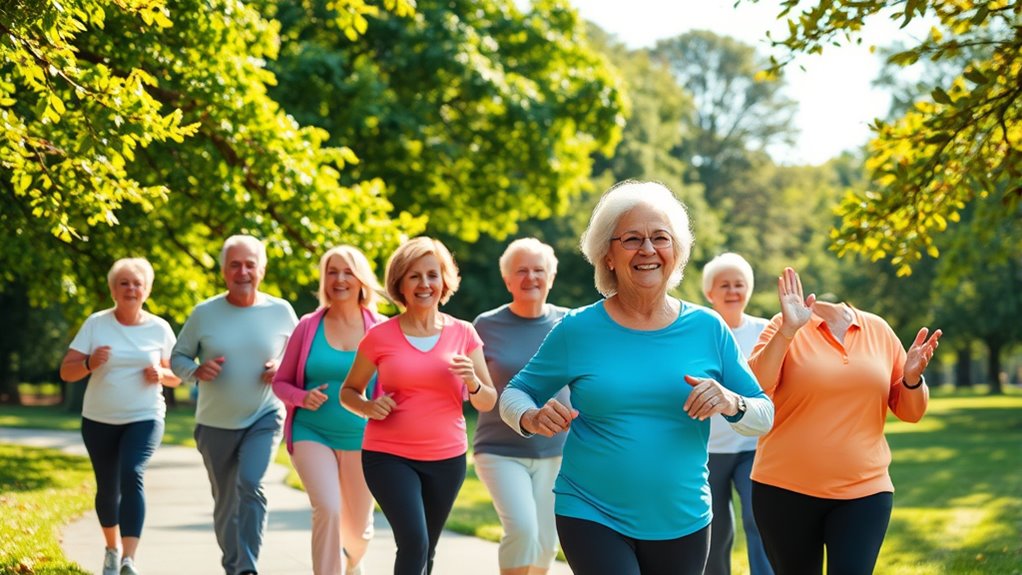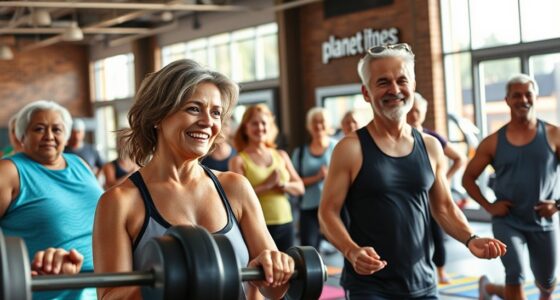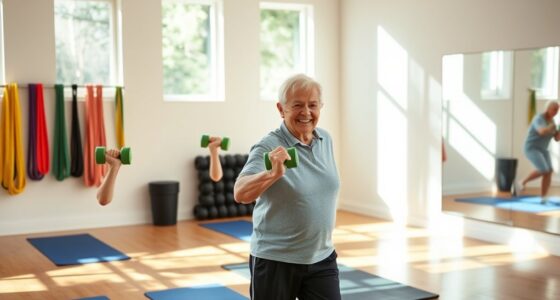Walking exercises are a fantastic way to boost your mobility and energy as a senior. Regular walks can improve your cardiovascular health, strengthen your muscles, and enhance your balance. Start with a gentle warm-up, then incorporate key exercises like side steps and knee ups. After your workout, cool down with deep breathing and stretches to maintain flexibility. You’ll feel accomplished and energized. Want to discover more ways to make the most of your walking routine?
Key Takeaways
- Engage in daily walking sessions of at least 30 minutes to improve cardiovascular health and increase energy levels.
- Include side steps and heel touches in routines to enhance balance and lateral mobility, reducing fall risk.
- Start with effective warm-up techniques like marching in place and side steps to prepare the body and prevent injuries.
- Incorporate arm exercises during walking to boost overall workout effectiveness and strengthen upper body muscles.
- Conclude with a cool-down phase, practicing deep breathing and stretches to promote relaxation and flexibility post-exercise.
Benefits of Walking for Seniors
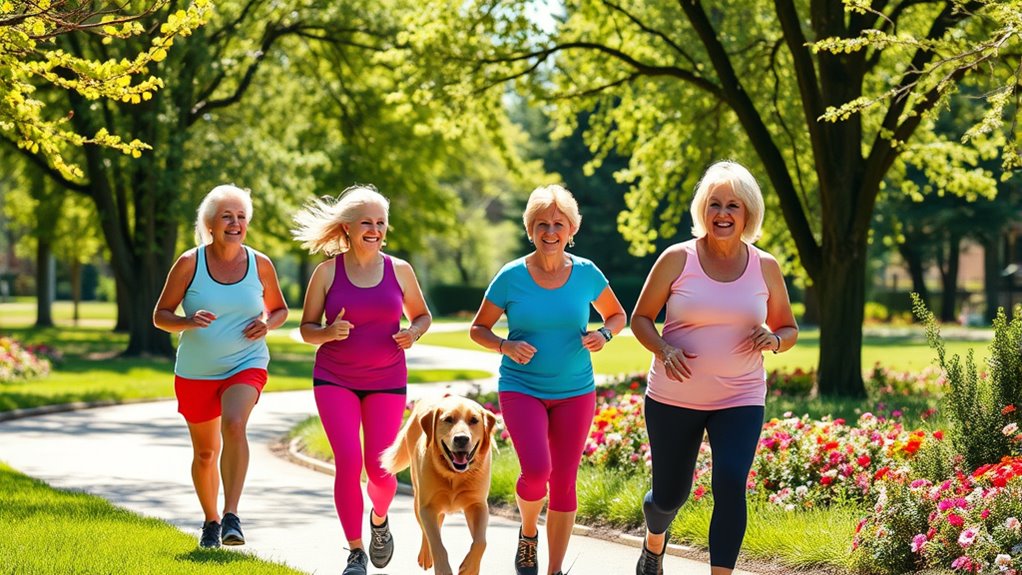
Walking offers numerous benefits for seniors, not only keeping you active but also greatly enhancing your overall health. This low-impact exercise minimizes stress on your joints, making it perfect for maintaining mobility. Additionally, regular walking can be enjoyed in scenic views that enhance the outdoor experience. Studies show that listening to classical music while walking can further improve cognitive function and mood, making your walks even more enjoyable. Engaging in physical activity like walking is essential for maintaining involvement in daily routines and social interactions, which are crucial for emotional well-being.
Regular walking boosts your heart rate and improves blood circulation, which can help prevent cardiovascular issues. As you engage in walking routines, you’ll strengthen your muscles, enhancing your balance and coordination—essential factors to help prevent falls. Incorporating AI-driven analytics can help you track your progress and set achievable goals for your walking routine.
Increased energy levels and improved mental well-being are also significant benefits you’ll experience, leading to a more fulfilling lifestyle. Additionally, incorporating essential oils like peppermint oil can provide refreshing support for respiratory health during your walks.
Effective Warm-Up Techniques

Before diving into your walking routine, it’s important to warm up properly to prepare your body and reduce the risk of injury. Engaging in activities like marching in place increases blood flow and gets your muscles ready. Maintaining good posture enhances your core engagement for better stability. You can also incorporate side steps to activate lateral muscles and improve coordination. Establishing healthy boundaries within your exercise routine can help guide your limits and ensure you don’t overexert yourself. Regular warm-up activities can also reduce injury risks associated with physical exercise for seniors. Additionally, warming up can improve your overall exercise performance by enhancing muscle elasticity and joint mobility. Incorporating a proper warm-up routine is crucial as it mirrors the essential steps in commercial juice production where preparation ensures optimal outcomes. Ensuring you have the right vacuum cleaner performance metrics in mind can also help you choose the best equipment for maintaining a clean and safe exercise environment.
| Warm-Up Activity | Benefits |
|---|---|
| Marching in Place | Increases blood flow |
| Side Steps | Activates lateral muscles |
| Good Posture | Enhances core stability |
Tailor the pace to your fitness level so you can comfortably prepare your body. Remember, if you can’t go too fast, that’s okay! Look forward to feeling energized the entire time.
Structured Workout Overview
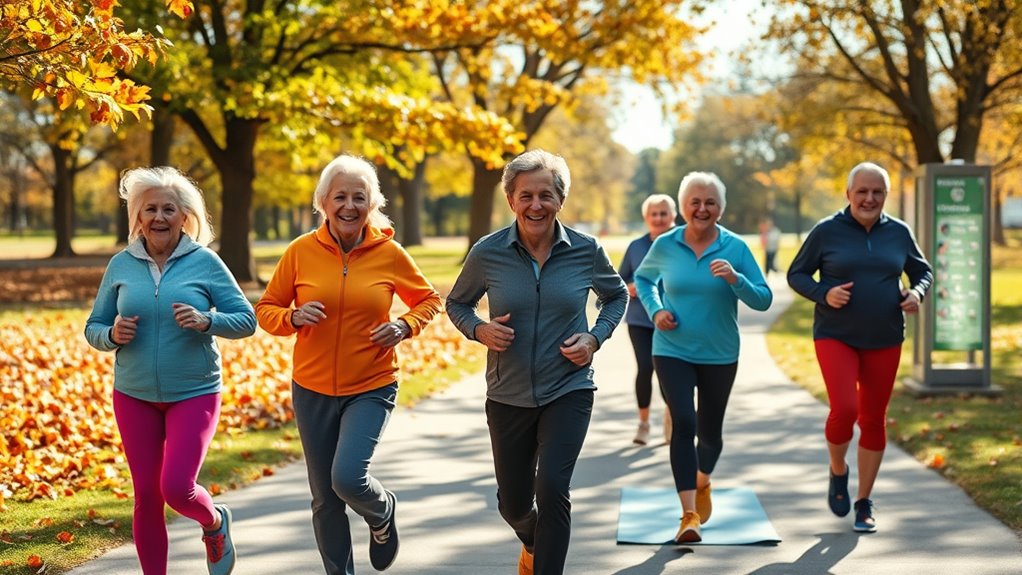
To enhance your fitness routine, a structured workout can effectively combine various movements that improve coordination and balance. This 10-minute session is divided into 30-second intervals, focusing on exercises like side steps, knee ups, and heel touches.
Starting with a gentle warm-up, you’ll march in place and perform side steps to prepare your body, reducing the risk of injury. Engaging in this structured workout can also help alleviate feelings of isolation in seniors, promoting seniors texting humor as a means of connection. The routine emphasizes continuous movement, incorporating arm exercises to elevate your heart rate and boost cardiovascular health. Additionally, incorporating watering techniques into your routine can ensure that any houseplants you have remain healthy and vibrant, enhancing your living environment. Engaging in this structured workout can also enhance problem-solving and innovative thinking, which are key benefits of creative practice. Furthermore, incorporating eco-friendly materials into your workout gear can contribute to sustainable fashion practices. Also, participating in outdoor activities such as camping locations can provide opportunities for exercise in a natural setting.
After the workout, a cool-down phase featuring deep breathing and leg stretches promotes relaxation and flexibility. By regularly participating in this structured walking workout, you can improve your mobility, increase energy levels, and support your overall health.
Key Exercises for Mobility
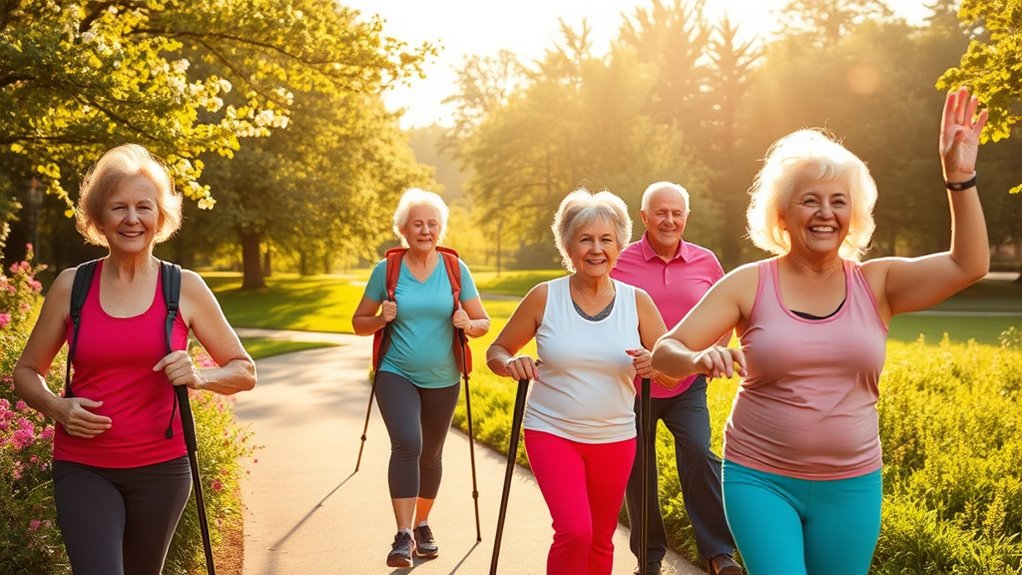
Enhancing mobility is essential for seniors, and incorporating specific exercises into your routine can make a significant difference.
Start with side steps to engage your hip and leg muscles, boosting lateral mobility and balance. Heel touches are great for improving coordination and stability while strengthening your core. Engaging in these exercises can also help improve cognitive development by promoting physical activity. Additionally, regular physical activity can help reduce the risk of tick-borne diseases, especially when exercising outdoors. Creating an environment that supports elderly care can further enhance the effectiveness of these exercises. Furthermore, regular puppy socialization can provide companionship and motivation for seniors during their exercise routines.
You can also perform knee ups to enhance lower body stability, which is imperative for daily activities. Don’t forget about forward and backward walking; it targets your posterior chain muscles, helping prevent falls.
Keep your movements continuous during these exercises to promote cardiovascular health, which is fundamental for overall energy and well-being. Additionally, practicing stress management techniques can further support your physical activity by reducing anxiety and enhancing focus during exercises.
Cool Down and Stretching Practices
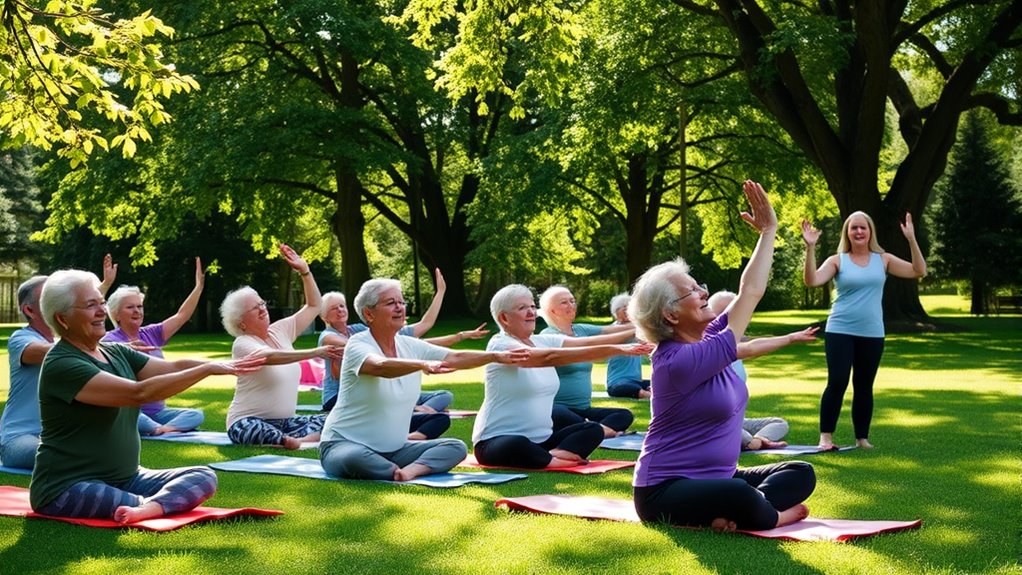
As you finish your walking routine, it’s important to include a proper cool down and stretching practices to help your body shift back to a resting state.
This step is crucial for lowering your heart rate and promoting relaxation. Here are some effective techniques to incorporate:
- Deep breathing: Focus on inhaling deeply and exhaling slowly to calm your body.
- Calf stretches: Stand with one foot behind the other, keeping your back leg straight. Incorporating essential oils such as lavender for relaxation can further enhance the calming effects of your cool down routine. Additionally, incorporating high-fiber foods like chia seeds can help support overall wellness. Chia seeds are also a great source of omega-3 fatty acids, which can aid in reducing inflammation after exercise.
- Leg extensions: Gently extend one leg at a time to improve flexibility.
- Static and dynamic stretches: Use both types to enhance muscle recovery. Engaging in regular stretching can also support emotional well-being by creating a sense of accomplishment.
- Proper alignment: Make sure your knee is over your ankle during stretches to prevent injury.
Regularly practicing these techniques can greatly boost your mobility and balance. Additionally, engaging in regular physical activity can help reduce symptoms of anxiety and depression often seen in conditions like dementia and Parkinson’s.
Reflections on Your Workout Experience
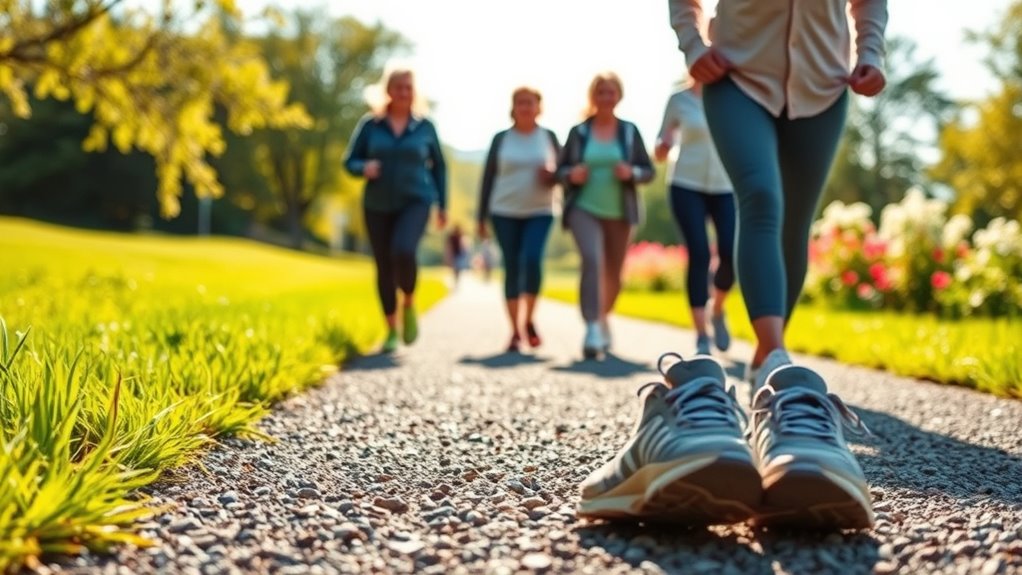
After your workout, take a moment to notice how you feel both emotionally and physically.
You might find that a sense of accomplishment boosts your mood, while improved flexibility or strength enhances your daily activities.
Reflecting on these changes can motivate you to keep moving and enjoy the many benefits of staying active.
Emotional Responses Post-Workout
While you might feel physically tired after a workout, the emotional benefits can be invigorating. Engaging in physical activity releases endorphins, lifting your spirits and enhancing your overall well-being.
Reflecting on your workout can deepen these feelings. Consider these aspects:
- Acknowledge your personal progress and achievements, boosting your self-esteem. It’s important to remember that emotional readiness can significantly enhance your overall experience.
- Share your feelings with others, strengthening social connections.
- Practice mindfulness during cool down and stretching, cultivating body awareness. Additionally, practicing grounding techniques can help you stay centered and fully appreciate your workout experience.
- Reflect on the enjoyment of the workout, reinforcing a positive mindset.
- Anticipate future sessions, fueling motivation to stay active.
Additionally, just as the recent regulatory clarity in the crypto space encourages continued investment, embracing these emotional responses not only enhances your mood but also encourages continued participation in your fitness journey, ultimately promoting both mental and physical health.
Physical Changes Observed
Reflecting on your workout experience, you’ll likely notice several physical changes that contribute to your overall health. Regular walking exercises can greatly enhance your cardiovascular health, improving your heart rate and blood flow. You might also find yourself feeling more energetic and mobile as your leg and core muscles strengthen.
Here’s a quick overview of these changes:
| Change | Benefit | Result |
|---|---|---|
| Improved Cardiovascular | Increased heart rate and blood flow | Enhanced energy levels |
| Strengthened Muscles | Better mobility | Greater independence |
| Enhanced Balance | Reduced fall risk | Increased confidence in movement |
| Increased Flexibility | Alleviated muscle tension | Improved physical comfort |
These changes not only foster wellness but also inspire you to maintain an active lifestyle for ongoing health benefits.
Tips for Maintaining an Active Lifestyle
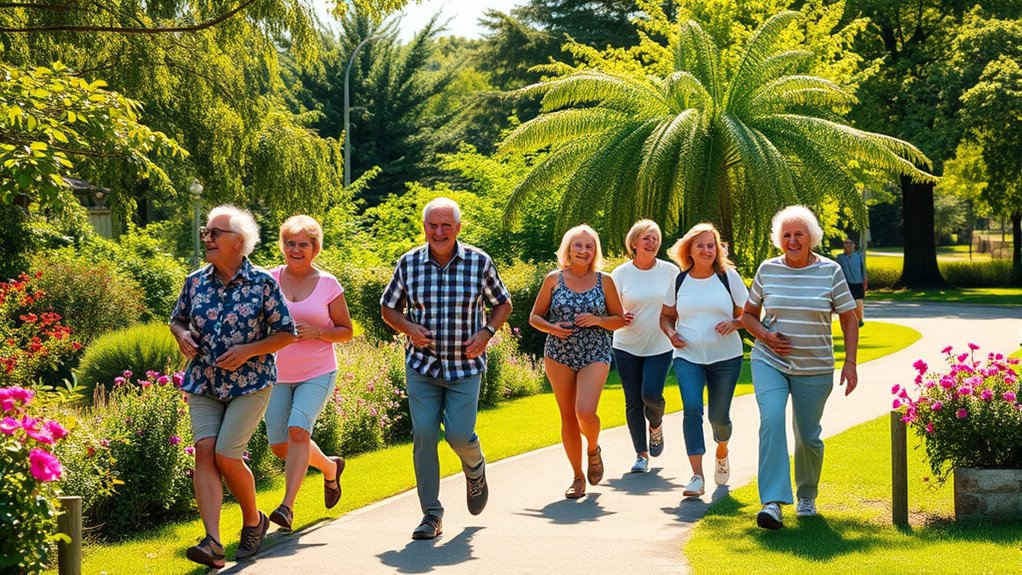
To maintain an active lifestyle, it’s essential to find enjoyable ways to incorporate movement into your daily routine. Here are some tips to help you stay engaged and motivated:
- Walk for at least 30 minutes daily: This boosts your cardiovascular health and mobility.
- Add variety to your routine: Incorporate side steps and heel touches to improve coordination and balance.
- Start with a warm-up: Prepare your joints and muscles to reduce injury risk.
- Cool down and stretch: Maintain flexibility and alleviate muscle stiffness after walking.
- Set achievable goals: Focus on small distances or durations to keep you motivated and active.
Frequently Asked Questions
What Is the Number 1 Exercise to Increase Balance in Seniors?
The number one exercise to increase balance in seniors is the single-leg stand. It challenges your body’s ability to maintain equilibrium by having you balance on one foot.
You can practice this for just 10 seconds on each leg throughout the day. Doing so can greatly improve your balance and reduce your fall risk.
Combine this with movements like heel-to-toe walking for even better coordination and stability. You’ll feel more confident and secure in your movements.
What Is the 6 6 6 Walking Rule?
When it comes to the 6 6 6 walking rule, you’re in for a treat that keeps you on your toes!
This method suggests you walk for 6 minutes, take a 6-minute break, and repeat this cycle six times. It’s a fantastic way to build your stamina without wearing yourself out.
What Is a Good Walking Program for Seniors?
A good walking program for you should include at least 150 minutes of moderate aerobic activity each week.
Start with warm-up exercises like marching in place to prepare your body. Incorporate varied walking exercises, such as heel touches and knee ups, to enhance balance and coordination.
Gradually increase your walking time and intensity, and always listen to your body.
Finish with cooling down stretches to improve flexibility and support recovery.
Can Walking Increase Energy Levels?
You might wonder if walking can really boost your energy levels. The truth is, it absolutely can!
When you walk regularly, your blood circulation improves, delivering more oxygen to your cells. This process enhances energy production and releases endorphins, lifting your mood.
Plus, brisk walks stimulate cellular activity and help regulate your sleep patterns, leading to better rest.
Conclusion
As you lace up your shoes and step into a world of movement, remember that every stride is a brushstroke on the canvas of your vigor. Walking not only strengthens your body but also paints your days with energy and joy. Embrace the rhythm of your heart and the whispers of your muscles, and let each walk be a celebration of your mobility. Keep striding forward, and watch as life unfolds its vibrant colors before you.
